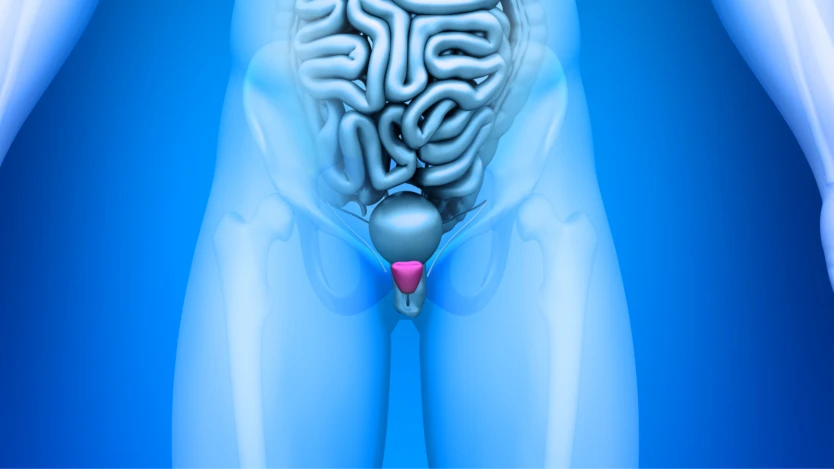Prostate laser surgery: types, advantages and complications

- When should I opt for laser prostate surgery?
- Types of lasers for prostate surgery
- Possible complications after laser prostate surgery
- Advantages of prostate laser surgery
- What is the best laser prostate surgery?
When should I opt for laser prostate surgery?
- There are several types of laser prostate surgery, the best known being the green laser, thulium laser and holmium laser.
- Laser prostate surgery provides the patient with numerous advantages associated with recovery and minimisation of complications.
- Although they are minimal, there are also some possible complications of laser prostate surgery and we explain them in this article.
Laser prostate surgery is required when a patient suffers from urination problems associated with a benign prostate growth obstructing the urethra (the tube that connects the bladder to the outside), which can cause discomfort ranging from difficulty in emptying the bladder completely to the need for permanent catheterisation.
When the symptoms of benign prostatic hyperplasia cannot be alleviated with pharmacological treatments, the only possible solution is reduction by surgical intervention.
To alleviate these symptoms there are several surgical techniques, such as the conventional transurethral resection of the prostate or open prostatectomy; the urethral release operation with Urolift system, which allows outpatient surgery but only on prostates up to a certain size; and laser prostate surgeries, which allow minimally invasive surgery and a much faster recovery thanks to the minimisation of bleeding.

Do you need laser prostate surgery?
Request a free and immediate appointment with our specialists in Urology
Although other surgeries for benign prostatic hyperplasia solve the problem of urethral obstruction, the use of laser techniques provides a series of advantages associated with recovery, reduction of complications and precision that traditional surgeries (TURP and prostatectomy) cannot compete with. It is worth mentioning that prostate surgery with the Urolift system is a different type of prostate surgery in which no tissue is damaged.

Types of lasers for prostate surgery
GreenLight Laser
GreenLight laser prostate surgery was one of the first to be established around 15 years ago and is the forerunner of more modern lasers such as the holmium laser and the thulium laser, which we will explain below. The green laser for prostate surgery was first used in the late 1990s and has been improved over time.

Do you need greenlight laser prostate surgery?
Request a free and immediate appointment with our specialists in Urology
The main use of the green laser is for the performance of prostate photovaporization, which, although it reduces the size of the prostate, does not allow the removal of prostate tissue for analysis. In addition, the time required for the intervention is longer than with other types of laser due to its physical characteristics.
In any case, it has advantages over conventional techniques (TURP and prostatectomy) as it reduces the length of hospital stay and recovery time, as well as minimising the possibility of complications.

Holmium laser
The holmium laser is more modern than the green laser and has characteristics that allow the surgeon to perform techniques such as enucleation (which allows results similar to a radical prostatectomy but with minimally invasive surgery) as well as vapour resection, which allows prostate tissue to be obtained for analysis.
Moreover, photovaporization of prostate tissue can also be performed in the same way as green and thulium lasers.
The ability of the holmium laser also stands out because it allows the surgeon to operate on any size of prostate, something that is not always possible with the green laser, for example.

Do you need holmium laser prostate surgery?
Request a free and immediate appointment with our specialists in Urology
At Operarme.es we work with the surgeon who pioneered the use of the holmium laser for the treatment of BPH in Spain, Dr. Ildefonso Santos García-Vaquero.
Finally, in the same way as the green laser and the thulium laser, the holmium laser has the advantage of reducing recovery times and reducing complications to a minimum.
Thulium laser
The latest and most advanced laser for the treatment of benign prostatic hypertrophy is the thulium laser. This laser allows the urologist to operate on almost any size prostate (this is usually subject to the surgeon's discretion and the individual case) and significantly reduces surgery, hospitalisation, catheterisation and recovery time. It also minimises intra- and post-operative complications.

Do you need thulium laser prostate surgery?
Request a free and immediate appointment with our specialists in Urology
Prostate surgery with the thulium laser allows the techniques of vaporisation and vapour resection to be performed, the latter allowing tissue recovery for analysis. In addition, the enucleation mentioned in the Holmium is also possible with the thulium laser, although this is at the surgeon's discretion.
Possible complications after laser prostate surgery
Despite the fact that laser prostate surgery allows for the minimisation of complications, especially compared to traditional prostate surgery, and its many advantages, as with any other surgical procedure there is the possibility of complications and it is important to be aware of them:
- Little or no improvement in symptoms: In prostate surgery, there is a possibility that after surgery there may be no improvement in symptoms, although this happens very rarely and in cases of severe BPH.
- Urethral stricture: This complication is the narrowing of the urethra, either completely or only in one area, after surgery. Like the others, it is very rare in prostate laser surgery.
- Urinary incontinence: This is a complication more common in conventional surgery than in laser prostate surgery, but during surgery the bladder outlet and the muscles that control it may be damaged, causing incontinence.
- Perforation of viscera (bowel, bladder, rectum...): This is very unlikely and is due more to malpractice by the surgeon than to a problem associated with the operation itself.
- Haemorrhage: This is a possible complication in all surgeries, although in the case of laser techniques it is practically impossible thanks to the photo coagulant properties of the laser that allow cauterisation of the venous capillaries as the process progresses.
- Venous thrombosis: This is a complication associated with anaesthesia and the postoperative period and is prevented by means of drugs and a series of care measures during hospitalisation.
- Retrograde ejaculation: This is a common complication in prostate surgery, as due to the association of the prostate with the formation of semen, it is possible that when ejaculation occurs, it is produced towards the inside of the bladder instead of towards the outside. This does not imply any problem for the patient's health or sexual enjoyment, as the patient will retain the enjoyment of orgasm and the semen will be expelled during urination along with the urine. Also, the occurrence of retrograde ejaculation after laser prostate surgery is slightly less than with conventional surgeries.
- Erectile dysfunction: Although possible, the occurrence of erectile dysfunction after laser prostate surgery is practically unlikely. This would require damage to the associated muscles and nerves and in minimally invasive BPH surgery such as laser techniques the precision is very high.

Advantages of prostate laser surgery
After discussing the possible complications associated with laser prostate surgery, we will now mention its advantages. These are mainly associated with the improvement and comfort of recovery and hospitalisation times, although other aspects associated with the safety of the procedure are also worth mentioning:
- Faster surgery: In this aspect, the thulium laser stands out, allowing the surgery to be performed in around 30-45 minutes, slightly less than the duration of the holmium laser operation and considerably longer than the green laser. On the other hand, compared to conventional prostate surgery, laser surgery is much faster,
- Less intraoperative bleeding: The properties of the laser allow a haemostatic effect (cauterisation) in the tissue around the vaporised area, minimising bleeding to the maximum and consequently, the hospitalisation and recovery time.
- Reduced hospital stay: Hospital stay is reduced from 3 to 6 days for TUR to 24 hours in most cases of laser prostate surgery.
- Minimal complications: The precision of these minimally invasive techniques together with the properties of each laser allow surgery with minimal complications.
- Allows treatment of patients at risk: Patients with heart problems, advanced age or taking anticoagulants can undergo laser prostate surgery, something that is not recommended in a conventional operation.
What is the best laser prostate surgery?
In this case, it must be said that the most important thing is always the surgeon who performs the intervention, since a specialist in conventional surgery, for example, with a lot of experience and skill can perform a perfect intervention and an inexperienced one can perform a disastrous surgery with the laser.
Thulium laser surgery has a number of advantages over other laser technologies as well as being the most modern laser.

Do you need laser prostate surgery?
Request a free and immediate appointment with our specialists in Urology
Medical disclaimer: All the published content in Operarme is intended to disseminate reliable medical information to the general public, and is reviewed by healthcare professionals. In any case should this information be used to perform a diagnosis, indicate a treatment, or replace the medical assessment of a professional in a face to face consultation. Find more information in the links below:
